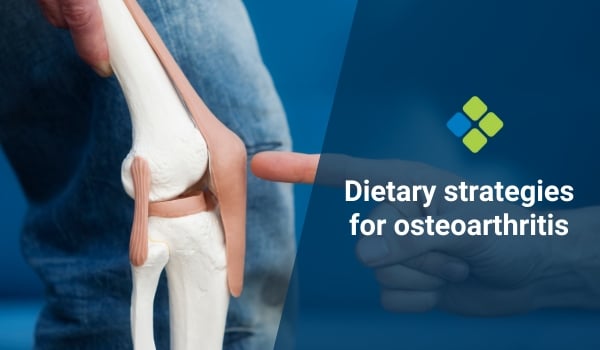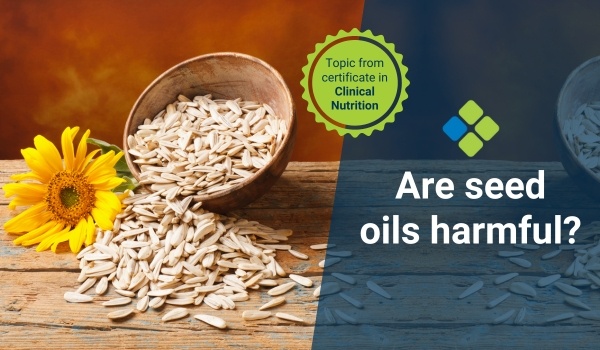Dietary strategies for osteoarthritis
Learn about medical nutrition strategies for reducing pain and swelling and improving quality of life for your patients with osteoporosis.

HealthCert Education
Did you know around 2.1 million Australians (1 in 11 people) suffer from osteoarthritis (1)? Osteoarthritis (OA) is the most common form of arthritis and is a leading cause of pain and disability worldwide, affecting an estimated 10% of men and 18% of women over 60 years of age (2). Its pathogenesis involves diverse risk factors such as age, biomechanical relationships, injuries and weight.
Earlier on, OA was thought to be a “wear and tear” degenerative joint disease, but it is now acknowledged that local and systemic inflammation play a key role in the disease progression and the emergence of pain.
Learn more about this topic in the HealthCert Professional Diploma program in Medical Nutrition Management – online nutrition training for GPs.
Current OA treatment is limited and largely confined to symptom management (3) through exercise programs or weight reduction (4), but a growing body of research suggests the role of anti-inflammatory foods and nutrients to reduce symptoms and slow OA progression (5-7).
The anti-inflammatory capacity of specific foods and nutrients is measured by something called the Dietary Inflammatory Index (8). Some foods that rank highly by this metric include:
- Green and other teas
- Beta-carotene, a Vitamin A precursor
- Magnesium-rich foods such as leafy greens, nuts and seeds, and wholegrains
- Flavanol-rich foods such as cocoa, kale, broccoli, and dark chocolate
In addition to the above, emerging research also suggests that certain supplements and dietary practices could benefit OA.
Omega-3 fatty acids
There is some evidence to suggest that high intake of omega-3s can help reduce inflammatory processes underlying OA symptoms (9), mostly from studies of fish oil supplements. As a rich source of omega 3 fatty acids, fish oil supplements have shown promise in reducing inflammation, alleviating joint pain, and improving overall joint health (10). From the food side, omega-3s can also be found in extra virgin olive oil, fatty fish such as salmon and sardines, nuts and seeds.
Limiting refined carbohydrates
Refined grains have been linked to higher levels of inflammatory markers in the blood, (11, 12) with the inverse being found for fibre-rich wholegrains (13). The amount of carbohydrates have also been shown to affect OA symptoms, with a study of patients aged 65-75 years of age demonstrating that a lower carbohydrate diet (compared to a low fat diet) led to a significant improvement in pain severity and quality of life in knee function (14). However, more research is needed.
Curcumin
Turmeric is the golden child of the health food world, and it’s easy to understand why; turmeric’s most active component, curcumin, is a powerful anti-inflammatory and antioxidant that may help treat or prevent diseases ranging from OA to ulcerative colitis and cancer. Some studies demonstrate curcumin in improving pain scores and quality of life in patients with OA (15, 16). It’s important to note that benefits were demonstrated in high quality supplements – adding turmeric to lattes or curries won’t have the same effect!
Knowledge of key nutrition for osteoarthritis can help GPs provide meaningful and actionable dietary guidance to empower patients with osteoarthritis. Dietary additions which emphasise anti-inflammatory foods rich in omega-3s, fibre, and flavanols and which limit refined carbohydrates and sugar may be helpful for reducing pain severity and swelling and help improve quality of life.
Learn more with the online HealthCert Professional Diploma program in Medical Nutrition Management.
– Lynette Law, Accredited Practising Dietitian
Engaging with this blog can help meet your annual
|
 How to claim your CPD hours How to claim your CPD hoursIf you consume educational webinars, podcasts, articles, or research on this blog, you can Quick Log CPD hours with the RACGP via the usual self-submission process. You will be asked to reflect on what you have learned, and you will require supporting evidence such as a screenshot. Download the RACGP’s guide to self-recording your CPD here. |
Read another blog: Medical nutrition & nightshades: A look at the evidence
References
1. Bennell KL, Bayram C, Harrison C, Brand C, Buchbinder R, Haas R, et al. Trends in management of hip and knee osteoarthritis in general practice in Australia over an 11-year window: a nationwide cross-sectional survey. The Lancet Regional Health – Western Pacific. 2021;12.2. Ackerman IN, Buchbinder R, March L. Global Burden of Disease Study 2019: an opportunity to understand the growing prevalence and impact of hip, knee, hand and other osteoarthritis in Australia. Internal Medicine Journal.n/a(n/a).
3. Bijlsma JW, Berenbaum F, Lafeber FP. Osteoarthritis: an update with relevance for clinical practice. The Lancet. 2011;377(9783):2115-26.
4. McAlindon TE, Bannuru RR, Sullivan M, Arden N, Berenbaum F, Bierma-Zeinstra S, et al. OARSI guidelines for the non-surgical management of knee osteoarthritis. Osteoarthritis and cartilage. 2014;22(3):363-88.
5. Liu Q, Hebert JR, Shivappa N, Guo J, Tao K, Zeng C, et al. Inflammatory potential of diet and risk of incident knee osteoarthritis: a prospective cohort study. Arthritis Research & Therapy. 2020;22(1):209.
6. Genel F, Kale M, Pavlovic N, Flood VM, Naylor JM, Adie S. Health effects of a low-inflammatory diet in adults with arthritis: a systematic review and meta-analysis. J. 2020;9:e37.
7. Cooper I, Brukner P, Devlin BL, Reddy AJ, Fulton M, Kemp JL, et al. An anti-inflammatory diet intervention for knee osteoarthritis: a feasibility study. BMC Musculoskelet Disord. 2022;23(1):47.
8. Shivappa N, Steck SE, Hurley TG, Hussey JR, Hébert JR. Designing and developing a literature-derived, population-based dietary inflammatory index. Public Health Nutr. 2014;17(8):1689-96.
9. Calder PC. n-3 polyunsaturated fatty acids, inflammation, and inflammatory diseases. Am J Clin Nutr. 2006;83(6 Suppl):1505s-19s.
10. Deng W, Yi Z, Yin E, Lu R, You H, Yuan X. Effect of omega-3 polyunsaturated fatty acids supplementation for patients with osteoarthritis: a meta-analysis. Journal of Orthopaedic Surgery and Research. 2023;18(1):381.
11. Della Corte KW, Perrar I, Penczynski KJ, Schwingshackl L, Herder C, Buyken AE. Effect of Dietary Sugar Intake on Biomarkers of Subclinical Inflammation: A Systematic Review and Meta-Analysis of Intervention Studies. Nutrients. 2018;10(5).
12. Nettleton JA, Steffen LM, Mayer-Davis EJ, Jenny NS, Jiang R, Herrington DM, et al. Dietary patterns are associated with biochemical markers of inflammation and endothelial activation in the Multi-Ethnic Study of Atherosclerosis (MESA). Am J Clin Nutr. 2006;83(6):1369-79.
13. Milesi G, Rangan A, Grafenauer S. Whole Grain Consumption and Inflammatory Markers: A Systematic Literature Review of Randomized Control Trials. Nutrients. 2022;14(2).
14. Strath LJ, Jones CD, George AP, Lukens SL, Morrison SA, Soleymani T, et al. The effect of low-carbohydrate and low-fat diets on pain in individuals with knee osteoarthritis. Pain Medicine (United States). 2020;21(1):150-60.
15. Zeng L, Yu G, Hao W, Yang K, Chen H. The efficacy and safety of Curcuma longa extract and curcumin supplements on osteoarthritis: a systematic review and meta-analysis. Bioscience Reports. 2021;41(6).
16. Shep D, Khanwelkar C, Gade P, Karad S. Safety and efficacy of curcumin versus diclofenac in knee osteoarthritis: a randomized open-label parallel-arm study. Trials. 2019;20(1):214.

 1800 867 1390
1800 867 1390





